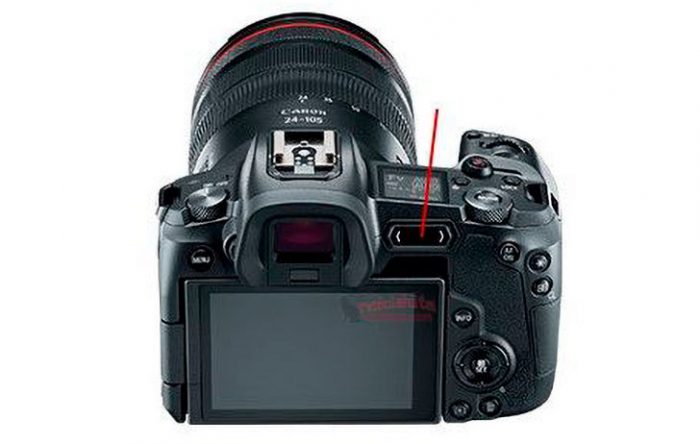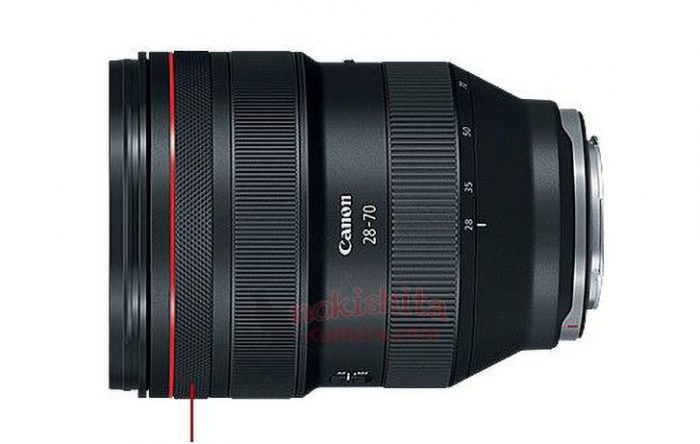
The Canon EOS R is the name of the upcoming full frame mirrorless camera that has been rumored for years. Now, it looks like official specs and images have leaked out at a number of sources online.
The Canon EOS R appears that it will use a new mount, the RF mount, and it will require an adapter in order to use EF lenses with it, which is contrary to previous rumors and speculation. Inside, the camera features a 30.3MP full frame CMOS sensor along with Canon’s famous Dual Pixel AF system.

Canon EOS R Key Features
- JPEG, RAW (14 bit), C-RAW
- Dual pixel RAW support
- 0.71x Magnification EVF
- ISO 100-40,000 (extended ISO 50-102,400)
- 1/8000 to 30 seconds and Bulb Shutter Speed Range
- Up to 8 fps Stills Capture (Servo AF: up to 5 fps)
- 4K/30p, 1080/60p, 720/120p
- 3.15″ Rear LCD with 2.1M-dots touch panel
- E-TTL II Flash System
- SD / SDHC / SDXC card slot
- LP-E6N / LP-E6 Battery
- Dimensions: 135.8 x 98.3 x 84.4mm
- Weight: 660g (including battery / memory card) · 580 g (body only)

Along with the camera, Canon is also expected to announce four new RF lenses at launch, including the RF 35mm f/1.8 IS STM Macro, RF 24-105mm f/4L IS USM, RF 50mm f/1.2L USM and the impressive RF 28-70mm f/2L USM.
We’ll see a lot more of this new camera and system in a couple days. In the mean time, what do you think about the details that have been leaked so far?
[More pics at Canon Rumors.]


Aha! So it will require an adapter – at least Canon didn’t break the laws of optics! After “debating” the possibility of the nonsensical thought that the new camera would use DSLR lenses without any kind of adapter previously, I’m glad to see the truth come out.
I am happy in what I have, and also still shoot both digital, and film, My gear is not this but it has a shutter, meter, and flash. And my Collection of Old Nikon Nikkor Manual focus lenses since during my film days that I can still use them always due to that I want FULL control in what I am doing, and what I am seeing. And my gear are also Fuji digital and Nikon, Canon, and Contax Film gear…. It is the Image that is important like I said so on You Tube…
If they go on blocking HDMI 4K output like they do on the 5D4 that i sold last week and replaced with an A7III for just that reason; that would mean there is no reason at all for anybody even remotely serious to consider buying it.
Well, now that’s a bit harsh, no? I daresay that most potential buyers of this kind of camera don’t think of video as the crucial reason to own it, even if they are “serious” photographers. After all, a “serious” videographer would likely look for a “real” purpose-built video camera rather than one designed for still shooting.
Bob one point you need to consider is that serious videographers, like myself, many times need a reliable 4K second camera. In a perfect world, that camera is a smaller body than the main cinema camera for gimbal work, etc. I own a Canon C200 but am in the market for a second 4K camera. I am really hoping that it can be Canon since I own many canon lenses. I am leaning towards the Sony A7S III as my second camera.
Well that’s all fine and well, but as the camera is primarily designed to shoot stills you being a serious videographer do not represent the demographic to whom Canon is trying to make this appealing. I imagine you are an outlier, as it were, and sadly the world of still photography does not revolve around you
Hmmm… well, I do not want to use a camera like this to shoot video either. if I must shoot a video of my grandchildren, I use my smartphone.Cannot think of any need for serious videos.
But you and I, Bob, may not longer be typical. Some of my friends are seriously interested in shooting video, and do so with their DSLRs. And they are long-time stills photographers by nature. The world may be changing. Cheers, Peter
Peter, the entire “shoot video with your DSLR!” thing has to do with the larger imaging chip size (and consequent shallower depth of field) to give the video a more “filmic” look – all fine and well. I get that.
But serious videographers can easily spend more for the associated gear to make these still-image-oriented cameras work more effectively -look at all the gadgets one can buy to aid with focusing (and for that matter the costly cinematic lenses with T-stops and precise focusing helicoids) – the Arri Pro support set costs $3K+ itself.
My point is, if you want to take the occasional video, fine – and (despite Apple’s ads) the larger sensor in a still camera over a phone may make for nicer end results. But if one is doing this full time, then it seems to me a still camera is not the appropriate tool for the job.
Maybe, but at every wedding I have attended in the past 5 years, the videographer was using a DSLR.
Yep I hear you Erik. I’ve been waiting on a Canon mirrorless that would rival the Sony A7III. I’m hoping that the pro version of this mirrorless would have two slots for memory and IBIS (which is a glaring omission for me) and hopefully good eye focus
It’s worth explaining what an abbreviation means for folks who do not know.
in body image stabilization
Peter no disrespect most folks who’s looking at these types of cameras should have an idea what on some of these abbreviations mean. We’re not talking $500 or 600 cameras. Thanks for your comment.
As i said, restricting use of an otherwise perfect machine is stupid.
As if you buy a Porsche that will only use the first two gears and to use the other 4 or six you have to buy one with the same engine (or even a smaller one) but a sligthly different type number and a much higher price tag.
It’s Canon’s choice but for the price of a 5.4 i get two Sony 7.3’s or a 9 and they don’t kill options in firmware.
Having to mix systems, carrying double stuff, swapping cameras for usage type; it’s all annoying if you have one that is suited to do it all in one package.
Not everybody who wants to have serious images has serious money to spend on gear and they should not be forced to do so.
While your much vaunted opinion of what constitutes “stupid” product design may be true, you final statement is bothersome in that it implies that you (or anyone) is “owed” something by a purveyor of goods. The same sentiment could be said for foodies – “not everyone who wants to eat great food has the money to spend on it and should not be forced to do so”. See the problem?
Your opinion is just that – and worth the bits into which it is encoded on this forum. Canon owes you nothing – and nobody is being “forced” to do anything. Otherwise we can all go whingeing to the fine folks at, say, Leica because it’s just not fair that their gear costs so much and the people really really need a rangefinder camera just so badly.
Certainly you cannot believe that “serious images” require some special gear! Enthusiasts or pros who can make “serious images” (however that would be defined) may well do so with a plethora of options. Golly, how were serious images created heretofore? Even – egads – in the days before digital?
In a free market, the success or failure of a product will depend on how well it sells at the price provided – it doesn’t even matter what that product costs (just ask Starbucks, where the coffee you drink costs them less than the cup they pour it into). So if it turns out Canon flops with this camera – which may well happen since there are other more mature mirrorless systems out there – then so be it. Remember, all the kerfuffle about whether legacy lenses will fit does not impact the manufacturer – once they sell a lens they see no income from the sale of that gear used. So while they may decide that having a body that allows the use of legacy glass may help make more sales, they have to temper that with the reality that they will not sell the new stuff in as large numbers as they might otherwise.
What you say is true Bob, the term stupid is only related to my desire to leave them since i feel it makes them lose a customer where they should not have to.
The emotion showing through is my feeling of being let down by a manufacturer of great gear.
But again, they do as they want and I try to get as much options for my money as i possibly can. The difference for them is minimal. A camera a year or so, some extra kit if something wears out, a piece of glass every few years. But i’m not the only one. Many of my friends/colleagues are doing the same thing. Going for a hybrid camera, that does both things well.
So many emotions, just about an HDMI signal in my case, sad that after some 30 years or so that irked me enough to switch systems.
But worry not, the AE-1 still gets to come out on a regular base.
Wow…Sony has been doing this for years. Nikon and Canon are only starting now? Are they doing so now because the sale of DSLR cameras has slowed down dramatically? Well, it has, but not because the world was waiting for full frame mirrorless … but because consumers have moved elsewhere, spending their money on entirely different types of electronics.
I find that to be sad, but it is a fact of life.
This chart by Statista, based on data from the Camera & Imaging Products Association, shows just how dramatic of a decline the camera industry has experienced since 2010.
(There has been a tiny increase in sales recently but definitely not great) https://www.businessinsider.com/digital-camera-shipments-15-years-decline-and-rise-2018-2
If you take out the incredibly polished mirror and reflex mechanism; and remove the well engineered and polished pentaprism, why does a mirrorless camera have to have such a high price tag? It’s all chips, software and sensor with the same shutter. Just a thought.
Well, because the price you sell something for should reflect the price folks are willing to pay for it, and (ideally) have nothing to do with the cost of making it – that’s marketing 101.
Of course, part of the reason for press releases like this is to create the buzz and thus, hopefully, some demand, for the product in question.
Bob one point you need to consider is that serious videographers, like myself, many times need a reliable 4K second camera. In a perfect world, that camera is a smaller body than the main cinema camera for gimbal work, etc. I own a Canon C200 but am in the market for a second 4K camera. I am really hoping that it can be Canon since I own many canon lenses. I am leaning towards the Sony A7S III as my second camera.
A public reply to a private question:
Just my personal opinion, feel free to have your own.
I think the 5D4 is a better camera but with some tweaking and kicking the menu’s around the A7iii provides very comparible images and in low light even better ones.
DxO seems to think about the same: https://www.dxomark.com/category/camera-reviews